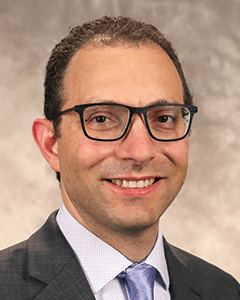Neurosurgery Treatments Bring Faster Recovery
December 30, 2024

Ammar Hawasli, MD, PhD
Neurosurgery patients have improved treatment options for common conditions that provide more relief with fewer complications.
Historically, adult patients with hydrocephalus, or a buildup of fluid in the brain, were treated by installing a shunt, or thin tube, just under the skin to drain off the fluid and deliver it to another part of the body where it is absorbed.
The complication with shunts is that they must be monitored closely in case they break, stop working or become infected possibly requiring another brain surgery -.
Last spring, Meritas Health Neurosurgery surgeons started performing an endoscopic third ventriculostomy (ETV) to treat hydrocephalus. For this procedure, a neurosurgeon drills a small hole in the skull – about half the size of a dime – and inserts a tiny camera to find the source of the blockage and clear the area so fluid can drain. ETVs take about an hour to complete, and patients are back home after spending one night in the intensive care unit.
“Unlike a shunt, which diverts the fluid rather than finding the source of the blockage, an ETV treats the problem and doesn't require an external man-made device,” said Ammar Hawasli, MD, PhD, with Meritas Health Neurosurgery. “Utilizing pathway created for the ETV, you can do other things like biopsies and even tumor and cyst resections with this technology and this tool.”

Stephen Reintjes Jr., MD
Another condition MH neurosurgeons can now address is diabetic neuropathy. This prevalent ailment occurs when high glucose levels injure nerves in the extremities, leading to pain and numbness. Traditionally, pain medicine was the only way to manage diabetic neuropathy.
Last year, the FDA approved the use of spinal cord stimulation (SCS) to treat diabetic neuropathy. For this treatment, neurosurgeons work with a specialist at the Meritas Health Pain Management Clinic. A pain management physician places a small wire in the spine that blocks the pain signals going to the brain. The patient is asked to keep track of their pain levels for a few days, until a follow-up appointment.
If the pain has significantly decreased over that time, a permanent device is placed by a neurosurgeon. The patient can leave the hospital the same day and no longer depend on pain medication.
“The benefit of the SCS procedure is that patients can wean off of their medicines which often carry side effects,” said Stephen Reintjes Jr., MD, with Meritas Health Neurosurgery.
Researchers at the National Institute of Diabetes and Digestive and Kidney Diseases estimate that 30% of people with diabetes have some form of diabetic neuropathy.
“The greatest advantage of offering these new treatments is that we are able to help patients who are really suffering with pain,” Dr. Hawasli said. “Getting patients back to their normal lives is highly rewarding.”